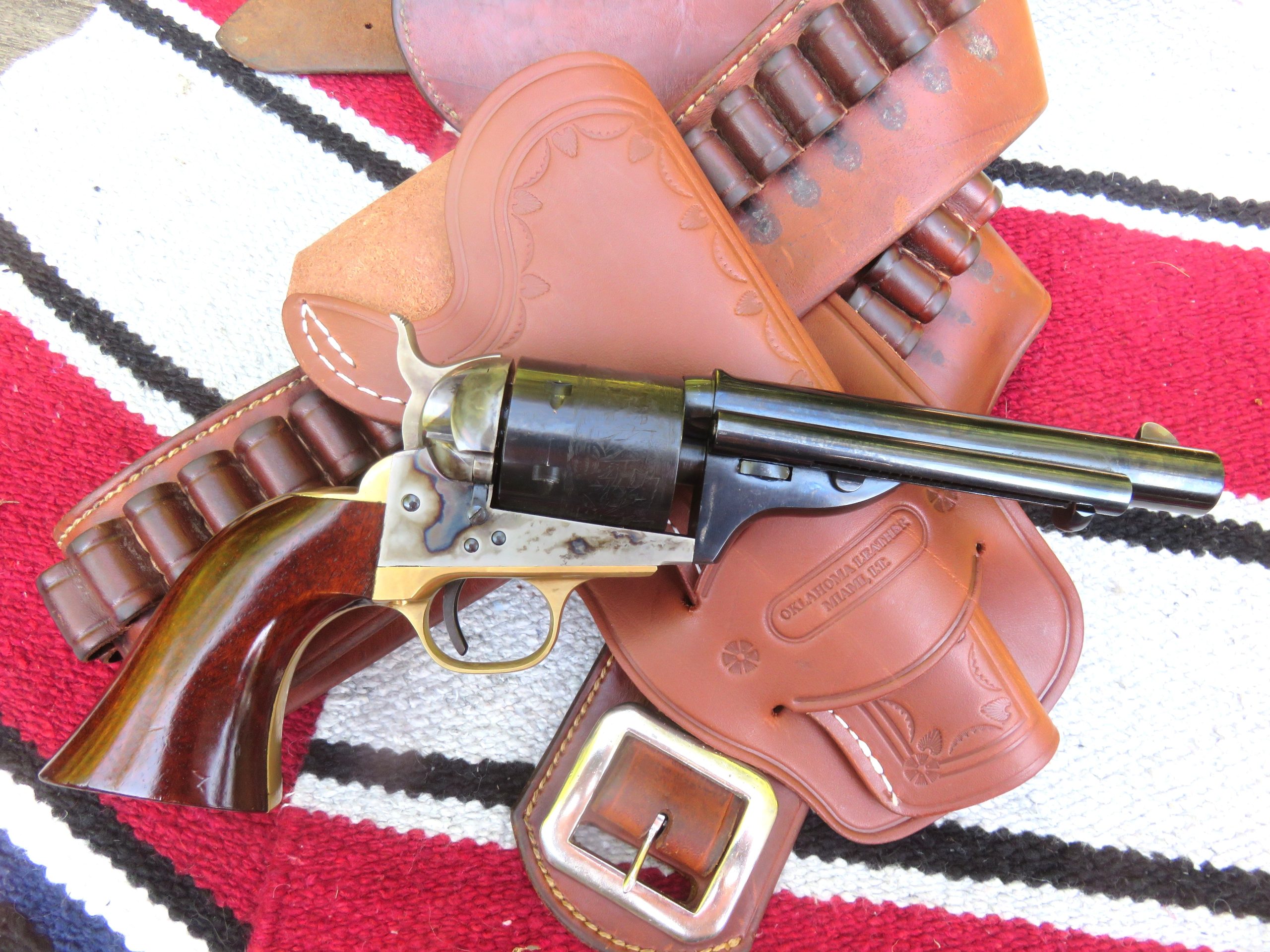
By Mike Nesbitt | Contributing Editor
Black powder cartridge shooting with revolvers has such a grip or hold on me that I wanted another six-gun for shooting and making smoke.
The selection of such a gun was narrowed slightly to be a new .44 Colt as offered by Cimarron Fire Arms. The new .44 Colt revolvers differ from the old ones in bullet and barrel dimensions which I’ve explained previously but those differences must be mentioned again. And I had the .44 Colt in mind because one of those revolvers, a copy of a Richards-Mason conversion with an 8-inch barrel, was already part of my “kit” but for the new gun I wanted a shorter barrel.
So, I headed out on the trail to find a shorter barreled .44 caliber revolver to use as a belt gun. In other words, I had no complaints at all about the 7 ½- and 8-inch barreled guns in .44 Colt that I have been using but just wanted a shorter one. That quest led me to one of the 1872 Open Tops by Cimarron Fire Arms, actually chambered in .44 Special caliber, with a 5 ½” barrel and the Navy sized grip. This gun is noticeably smaller than my longer barreled guns with the larger Army grip so I have tagged it as my “little .44.”
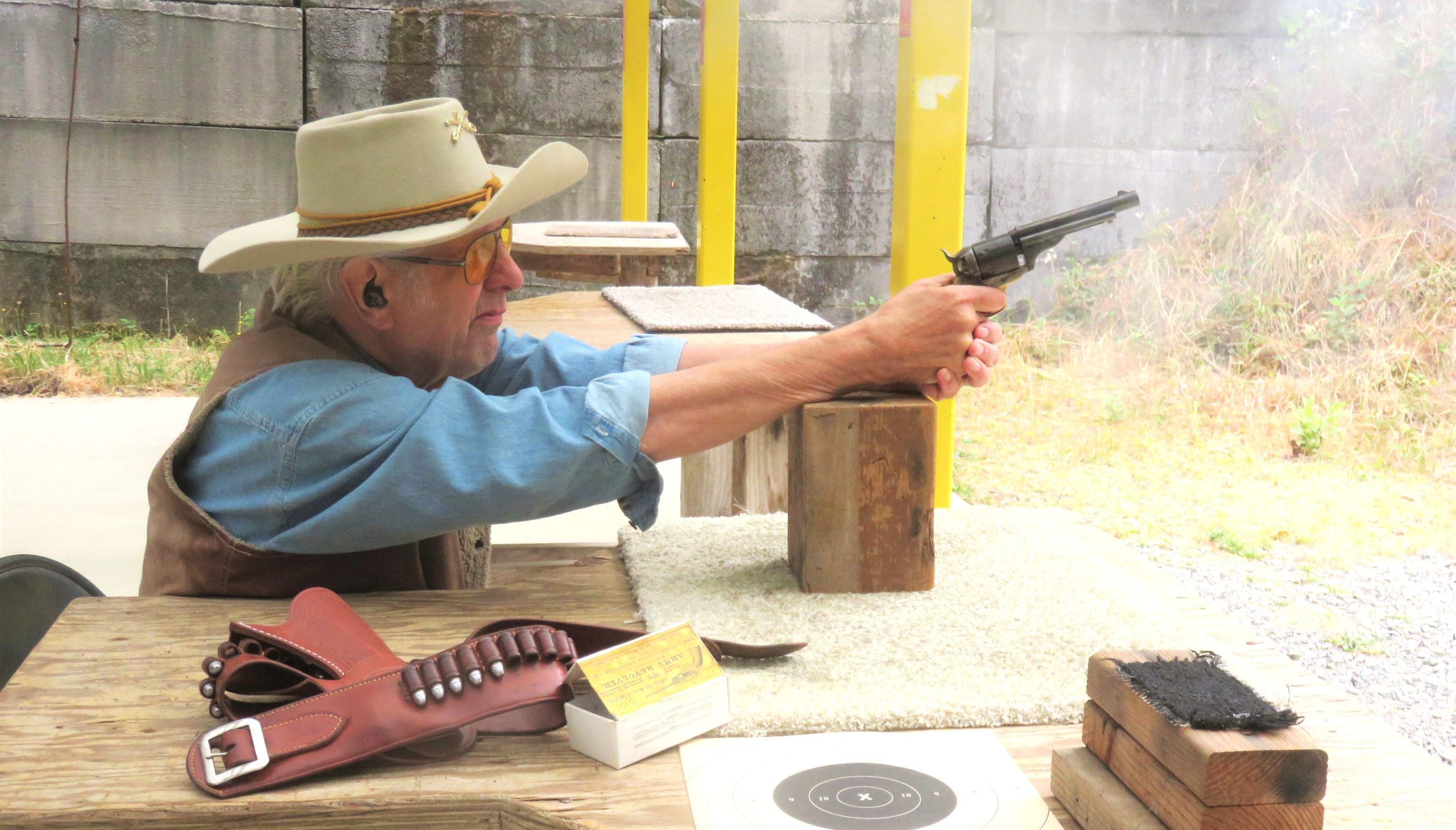
The Colt Open Tops from 1872 have a rather colorful background. They were designed by Colt’s engineers, Richards and Mason. Those names are more often linked with the conversion revolvers from 1871 as just mentioned; which were the Richards, the Richards Type 2, and the Richards-Mason six-guns which were all chambered for the .44 Colt cartridges. While those conversion revolvers might have used older parts from the percussion era, Colt’s 1872 Open Tops were made as new guns with newly designed parts, a real stepping stone toward the Peacemaker which came out just a year later.
There was very little variety in the Colt Open Tops of 1872, it was made, as far as I’ve seen, only with the 7 ½-inch barrel. And they were made only for the .44 Henry rimfire cartridge. To those of us who like centerfire cartridges, that seems like a step backwards but at the time it certainly was not. Back in 1872, the .44 Henry was very popular, much more popular than the .44 Colt, as shown by the sales of the Model 1866 Winchester and other guns made for the .44 Henry cartridge. The 1866 Winchester had topped over 125,000 guns at the end of 1874 while the ’73 in .44/40 was just getting started. The greatest variant I have noticed in the old guns was in their grips, early versions were made with the Navy sized grip (which is the same as on the Colt SAA or Peacemaker) and some later guns were made with the larger Army sized grip as on the 1860s in .44 cap & ball.
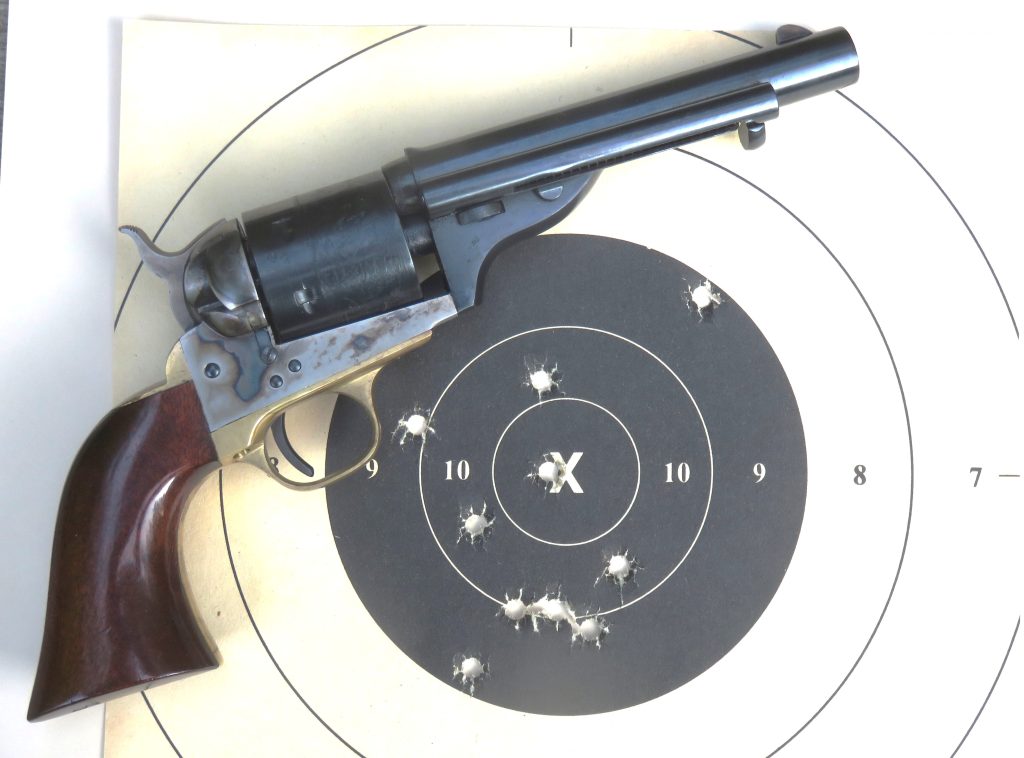
How long the Open Tops remained in Colt’s production is something I haven’t been able to pin down. Some references say they were made only in 1872-73 while others say they were made up to 1877. Regardless of the exact dates, we know that the Open Tops were made in fairly few numbers and total production is said to be about 7,000 guns.
My tastes for authenticity are satisfied by assuming that the barrel on the Cimarron copy that I have was shortened after leaving “the Colt factory.” Cimarron, of course, imports their version of the Open Tops with at least three barrel-lengths and they’ve had them made in several calibers, such as for the .38 Special, the .44 Russian, .44 Colt, and .44 Special, plus the .45 Colt cartridges.
I will loudly say “Hats off to Cimarron!” because they sent an original Colt Open Top back to Uberti so the old gun could be copied very accurately. Other than the barrel lengths and being made for centerfire cartridges, the only other difference is that the Uberti copies have a safety block in the hammer.
Like I said, this little .44 was to be used as a belt gun so one accessory that I bought even before shooting the gun was a holster made by Oklahoma Leather which came from Buffalo Arms Company. What I picked was the Single Loop Mexican style for the 5 ½” barrel which is priced at just $32.59. That holster was added to a cartridge belt that I’ve have for several years and with that outfit, I was ready to go.
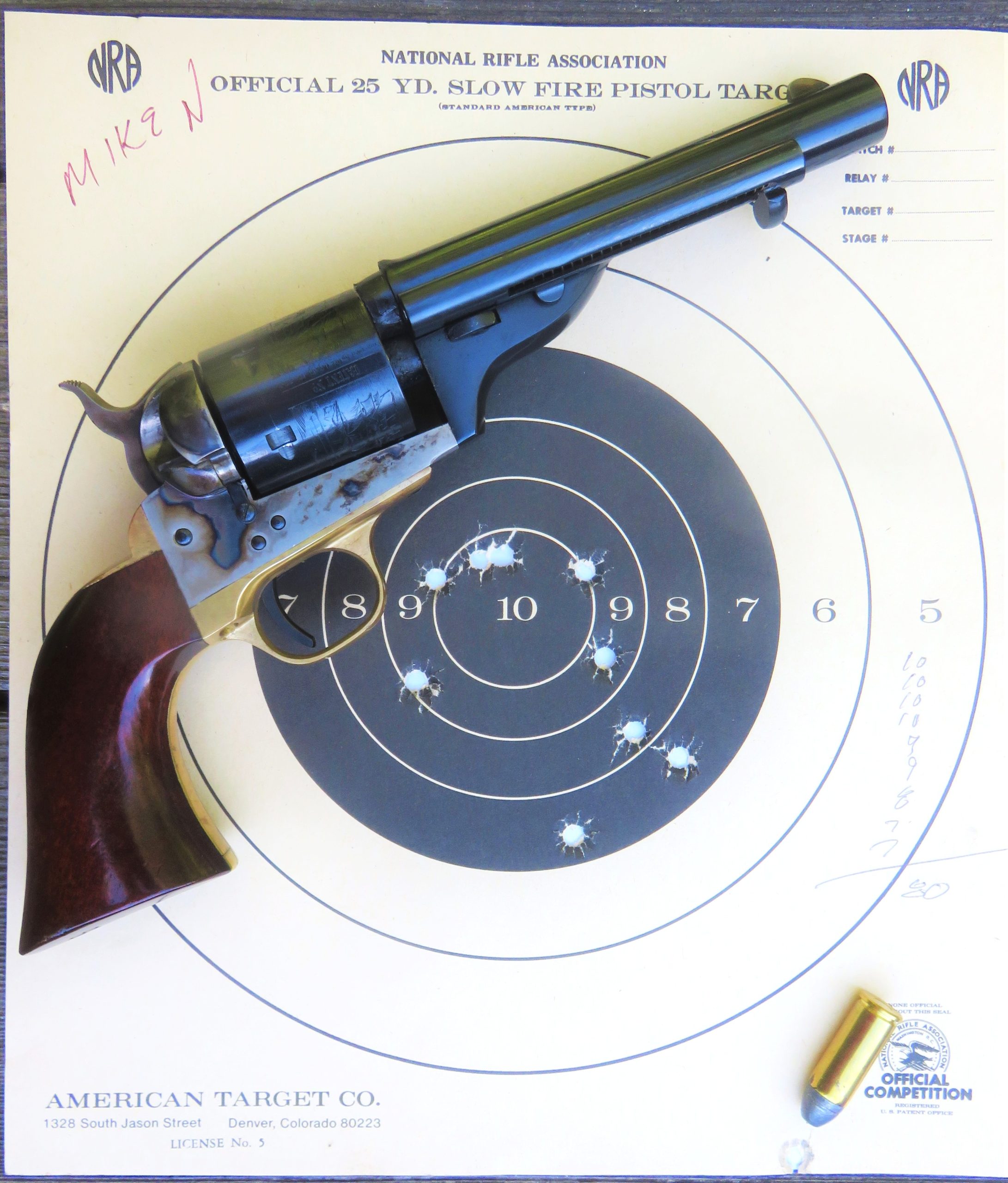
The gun itself pleased me right away, the trigger pull is very good (I like rather light trigger pulls) and the fit of the metal pieces and the grip could not be criticized. And while it is a .44 Special, as it is marked on the bottom of the barrel just behind the ejector rod head, my intention is to use it with black powder loads in either .44 Colt ammo or .44 Russian cartridges. Both of those shorter cartridges can be used with excellent performance and those cartridges also fit the era of the buffalo hunter that I enjoy representing.
Just how much this gun pleased me wasn’t realized until I shot it for the first time. That was done with a target posted at just 30 feet and shooting the gun while sitting at a bench, steadily holding the gun with both hands. Many of the reproduction revolvers, especially the cap & ball guns, tend to shoot high and I wanted to know where this .44 would be sending its bullets, so I held as tightly as I could right at the bottom of the bullseye, a 6 o’clock hold. To my delight, that’s just where the bullet hit, at 6 o’clock right below the black. The other four shots in the cylinder were also fired, making a rather nice group with three of the shots very close together.
That answered my first question very positively, to hit with this gun you had to hold dead on the target, right where you wanted the bullet to go. (Just the way we like ‘em!) I really didn’t have further questions about the gun but I did have some variance in the ammunition being used.
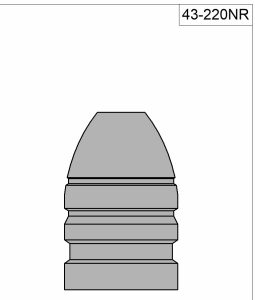
Those first loads used 21 grains of Schuetzen 3Fg powder under the 220-grain bullet from Accurate Molds’ #43-220NR, which has a small groove around the bullet above the crimp groove just to give the bullets “.44 Colt” look. (The old .44 Colt ammunition was outside lubricated and had the exposed groove around the bullet to hold the lube.) Other loads which were tried used 21 grains of Olde Eynsford 2F powder under the same bullet. The Olde Eynsford powder load had obviously more punch but the two loads seemed to hit about the same for both elevation and accuracy. Both loads performed very well.
Most of the old loads for the .44 Colt were listed as being loaded with more powder than what I was using. Powder charges up to 30 grains are shown in some of the old books as well as being printed on at least a few of the old cartridge boxes. The 1916 Winchester catalog shows the load in their cartridges for the .44 Colt to be loaded with 23 grains of black powder. Some years ago, the late Mike Venturino took an old .44 Colt cartridge apart to see what it actually held and that was 21 grains of powder. Following that excellent example, some of us have been using 21 grains of Olde Eynsford 2F ever since and from an 8-inch barrel the bullets cross the chronograph at 766 feet per second. This gun, with its 5 ½-inch barrel, will generate just a little less speed.
One feature about the Open Tops is the rear sight which is a simple groove in a raised “boss” on the rear end of the gun’s barrel. I find that a better sight to use than the notch in the hammer that was typical of the Colt percussion revolvers and the hammer sights are also found on the Colt Richards and Richards-Mason conversions as well as their replicas.
More shooting was done offhand but with the two-hand hold. My best target showed all five shots in the black and at this time I can’t remember which load was used to shoot that although I believe it was with the Schuetzen powder. I’m not finished with the Schuetzen powder loads at all, in fact, I did increase the loading to 22 grains just to see how it performs. That’s called “tweaking” the load and I’ve mentioned that before.
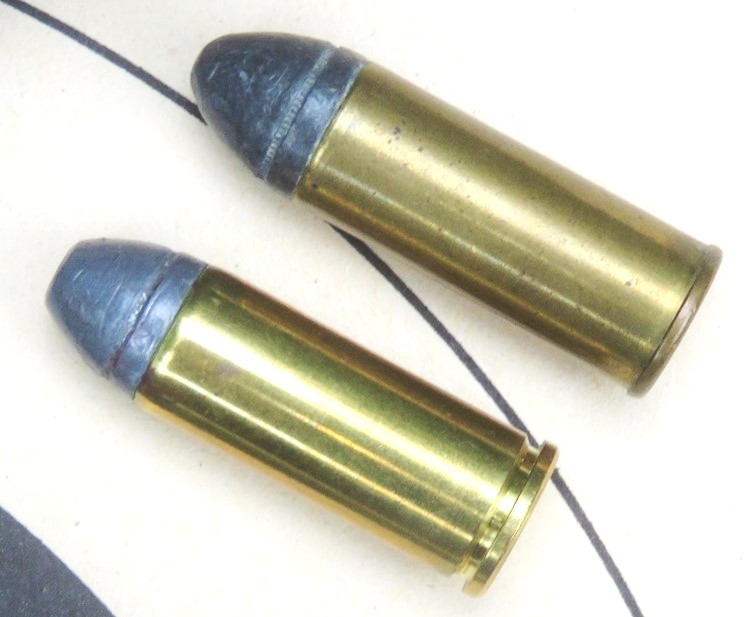
Most recently, five loads using the 22 grains of Schuetzen 3Fg powder were “speed checked” out of the 5 ½ inch barrel at just 550 fps, basically 200 feet per second slower than the same bullet powered by the Olde Eynsford 2F powder. However, accuracy was still quite good, giving me three X’s on the target at 30 feet.
While using the 21-grain load with the Olde Eynsford powder under the 220-grain bullets from the Accurate mold, this gun was used in an after-match which followed one of our Old West Centerfires Matches where buffalo guns were the main noise-makers. In that after-match, my .44 Colt helped me get a score of 80 points (with only 9 scoring hits, see the miss down at the bottom of the target where the loaded cartridge is pointing to it) which put me in a tie for second place. That tie was never broken because at our after-matches there is only one winner, the first-place shooter (in this case with a score of 84 points) takes the pot. I’m just pleased that this .44 Colt does rather well and I will be giving it several more chances.
For now, I’ll simply say again how much this “little .44” pleases me and how I expect to be using it with certain regularity, perhaps including on the Black Powder Revolver Match at Buffalo Camp. It fits the criteria for that with excellence. And if you’d like to learn more about this gun and its brothers, visit the Cimarron Fire Arms web site at www.cimarron-firearms.com. Their web site currently shows this model at out of stock but Cimarron also has a list of dealers and some of them, we must guess, should still have some of these revolvers new and in the box. I’ll say they’re really worth having and this one of mine will be shot a whole lot more.


